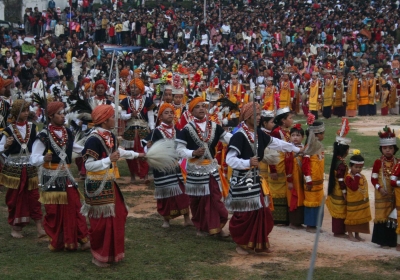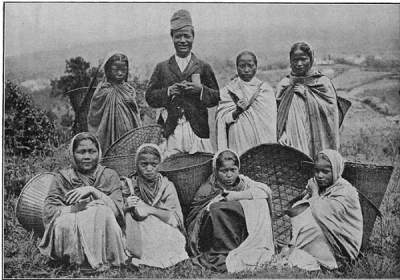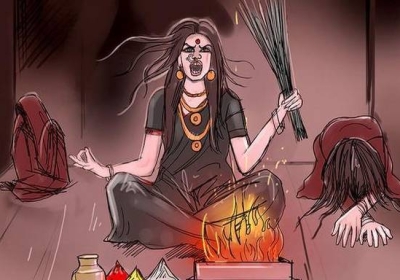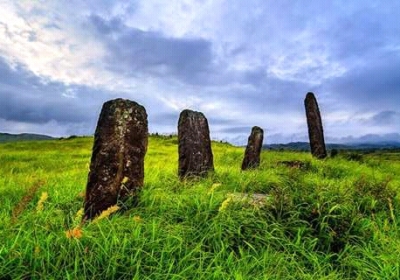Khasi Heritage: Folk Sciences and Ancient Wisdom
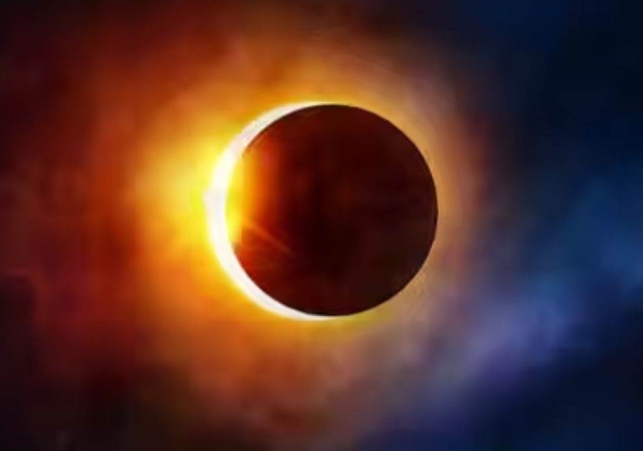
Ka Nam was happy at the shed, spending her life away from danger with the protection of the toad’s mask throughout the day, feeling safe and secure in the house of the sun. Ka Nam removed the mask at night only before going to sleep, not aware that on a full-moon day, the moon noticed her beauty after she kept the mask on her bedside. Meanwhile, the tiger reached his cave along with his companions for the feast, only to find that the girl had vanished. All his companions left him and the disgraceful event enraged him so much that he vowed to avenge and hunted for the girl. The tiger knew about the discrete escapade of the girl and trailed her route to heaven. He enquired from every celestial body but none could give him a definite reply, and Ka Nam was scared when she came to know about it. The moon had already revealed the beauty of Ka Nam to his sister, the sun, and both of them snatched away the toad’s mask and threw it away in the outskirt. Ka Nam was nervous when she could not find her mask, particularly when the tiger was already around. The tiger was given false information that the girl had died, while the moon was aware of it and burning the toad's skin, pretending to attend the fake funeral of Ka Nam and the tiger rushed hurriedly to mourn at the cremation pyre. At that moment, the tiger was pushed into the blazing fire of the pyre and was incinerated. Thereafter, Ka Nam was safe and happy, while the toad turned to cinder, and both of them failed to return back to the earth. The beauty of Ka Nam enamored the moon, who arranged a feast at home, by inviting his sister, the sun.
When the sun and Ka Nam arrived at his house, the moon had already smeared the seat for Ka Nam with latex. After the feast was over and it was time to bid farewell, Ka Nam was stuck in her seat that the sun had to pull her by force. The sun realised the motive of the moon and scolded him for his cruel intentions. The moon also quarreled with his sister about her shameless reaction on a pleasant occasion. The altercations continued outside along the path and culminated at the site where the toad’s skin was burnt. The sun was furious and threw the toad’s ashes at his face, while the moon also picked up the ash with a piece of singed skin and threw back at her. Both were cursing each other with offensive remarks and vowed to stay away from each other forever. The sun casts aspersion on the moon that people will shout and beat their drums to clamour his shamelessness. Similarly, an outburst of slander came forth from the moon also as he yelled that people would hide inside their houses and darkness would descend on the world in defiance of her disparagement. From that day, the sun prevailed during the day and the moon never appeared in daylight and hid beyond her presence in the night.
The seared skin of a toad retains its malevolent utility whenever it gets the opportunity to entrap the sun and the moon, in certain rare periodical instances. The periodical attack of the toad on the sun is the solar eclipse and on the moon is the lunar eclipse. That is why, in Khasi society, whenever there is a solar eclipse, people would stay at home, because it is dark during day hours. Likewise, whenever there is a lunar eclipse, people would shout and cry, beat drums or any other things to produce a loud sound as if to prevent the toad from engulfing the moon. True to the story, ash is found on the surface of the moon by Apollo 11 astronauts.
Frogs and toads belong to the same family of amphibian species. Both of them inhabited the streams and river banks or bed ponds and lakes amidst the weeds and plants with big leaves. They stroll the grasslands and swim in the water and often have a chance to view a glimpse of the reflection of the moon on still water. In Khasi folklore, frogs and eggs are hygienic creatures and always lay eggs in crystal clear water on the beds of flowing streams or stagnant ponds that are not polluted with any parasites or sewerage. The frogs lay eggs in a mass or cluster, while toads lay eggs in chains from one stone to a bunch of weeds or patch of soil. There is a vibrant tradition of a particular stream flowing into Kynshi river in Tiehnongbah village, near Pariong in the West Khasi Hills, which possesses a regular universal phenomena that predicts social and political situations in the world. The arrangements of eggs in the particular area of the streams depicted the change of season and events in the region and all over the world. Some people comment that it is a superstition, while others say it is a coincidence. However, coincidences can not be on a regular basis unless they are based on some ancient knowledge system that has declined with the onslaught of civilisation and modern science. From time immemorial, the ancient Khasi folklore narrated that the crowing of the rooster for beckoning the sunrise is a universal truth. The trunk and gentleness of an elephant and appendage on the beak of a hornbill and its hoarse voice are the outcome of the encounter with the sun, which is witnessed by the world over. The ash on the moon’s surface is an ancient Khasi folklore, which was substantiated by astronomical science in 1979. The colonisation of the pristine Khasi territories by British imperialism in the nineteenth century was predicted by the Tiehnongbah phenomenon. So is for the constitutional accession of Khasi Hima or independent provinces to the Indian union after Independence in 1947. The toad’s eggs predicted about the Hill State movement during the 1960s and the achievement of an autonomous State in 1972. The assassination of the U S president, John F Kennedy in 1963 and the Prime Minister of India, Indira Gandhi in 1984, and a few major world events were predicted by the Tiehnongbah phenomena. However, all these revelations remained hearsay as long as they couldn’t be substantiated by science and the ancient wisdom was depleted at a faster pace.
Hoi kiw! Ka Nam.
Diengsning ne dieng sohphie, ha law bniap ne ha law bah;
Ki soh ki sla ki khie, laiphew jingthaw te ba u jrah.
Kawei ka men armet, ї'u sohphie te ba ka threw;
Diengbah ka kiew artet, rynjup soh te ba ka kdew.
Ha kpoh ka pun l'i khun, ym lah shah sohphie ban duh;
Lada ka їoh kan klun, sha la їing kan rah sahuh.
Hangta la mih u khla, ha tnat dieng u shong sammut;
Kloi lan te u tyrwa, ban khynñiuh ha ban da lut.
Ynda lah kha khyllung, te u khla u lah dep kam;
D'u khun shynrang ym long, khun kynthei te un їalam.
La jrah ka riew punkhun, khla u pan da ka juban;
Ban lait ka їa buh shun, ka kohnguh katba u pan.
Tang mar їa khuid ka jhep, ba u khla te u ap dngong;
U thap ban shu rong klep, na law bniap u shong hi mnong.
Kynhun ki samla lud, ba kit um ha la ki ktang;
Rynsied u khla mar bud, їa ka Nam u rong hi jlang.
Tang poi te ha la krem, u syrpud te їa ka Nam;
Ï'u khla ka nguh ka dem, ha krem khla sule ki kam.
U khla la leit beh mrad, para kher te ban їawer;
Shet ja ka Nam kynrad, klang ka ding ba beh ka lyer.
Kyndit na lyngwiar dpei, ba i khnai i la wan mih;
Khana ka bneng pyrthei, mawbyrsiew te ba i krih.
Ka khnai te ka maham, ba u khla te un bam doh;
Khaweit hi her ka Nam, la kupar ban shoh ka ngoh.
Sohkhaw ka khnai ka pan, ban aibuit te їa ka Nam;
Ka jri ka kya ka tan, ban kiew joit kat sha ba lam.
Ym don ban lah kynjoh, їa ka Nam katba ka thmu.
To kup da snieh hynroh, ba ka khnai te ka kyntu;
Ka phang kaba jylliew, ki metbneng te ki kyrtoh;
Dur khmat kaba bhabriew, ba la kah da snieh hynroh.
Na krem ka phet hi soit, jri ka kya ba ki kyntiew;
Katta hi joit shi joit, markylliang te ba ka kiew.
La pat te ka Kong Ri, ba la san te ka Kong A;
Ka Nam halor diengjri, ka rynsied na ka dieng kya;
Shynna u mawsiang bneng, ngit-ly-ngit te ka lisan;
Na tbian la jrong hi kneng, ngai-ly-ngai te ba ka jlan.
Shatei te ym lah paw, la shathie ym lah їohi;
Mihngi kyrang ka saw, dum їongngit te ka sepngi.
H'u 'nai khatsaw synñia, ba la poi nyngkong ka Nam;
Ka pan їing sah basa, met mynsiem lah thait lah jrem.
Tang i tyrdum tyrdam, ba ka kup da snieh hynroh;
Ka dwar u khang hi tdam, ka Nam bapli ka la sngew poh.
Ka shang kylleng ka bneng, ban phet rieh te na u khla;
Ka Nam bhabriew ka deng, la kam shlan te ba kan phla.
Ka poi khatduh khatwai, ha tyngkong te jong ka sngi;
Ha khrum ka sem la ai, ba kan rieh miet la bad sngi.
Haba syntiat u bnai, da ka thei bhabriew u lap;
U khroh u kjor jyllai, ban їoh kem їa ka u thap.
Ka sngi kaba shida, ïa ka Nam la lam sh'u bnai;
Da bthit u riam kylla, dur lymphuiñ ban ïoh tyngkai.
Kynsan bitar ka sngi, la shet kylla te da u bnai;
Ḯaleh te markynti, ka Nam kam nang shano ban phai.
Ka sngi te ïa u bnai, ka khalah da u 'peisieh;
Artat ka tim ka mai, ïa ka Nam jynthet ka knieh.
Kyndit klynsan u khla, thadlongbneng ba u poi tiap;
Ia Nam u thwet u shla, la pyrshang tyngeh khlem lap.
Ka snieh hynroh la syang , ba lamler te ia u khla;
Budnam iathuh la thang, khla u iam te u pyrta.


